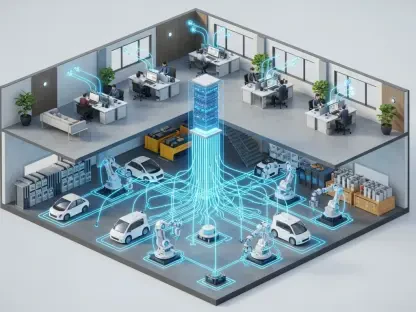The tech industry is reeling from the staggering financial projections surrounding OpenAI, a leader in artificial intelligence (AI), which is reportedly set to burn through an astonishing $115 billion by 2029. This figure, emerging from recent industry analyses, isn’t merely a number—it’s a bold indicator of an unprecedented investment surge sweeping across the AI sector. OpenAI stands at the forefront of what may be the most capital-intensive period in startup history, reflecting a broader movement where the race for AI supremacy demands astronomical resources. This isn’t just about one company’s ambitious budget; it’s a window into a transformative era where tech giants and startups alike are funneling billions into innovation. The implications of this spending spree extend far beyond corporate balance sheets, hinting at seismic shifts in global economics and technological landscapes. As the stakes rise, understanding the drivers behind these investments and their ripple effects becomes essential for grasping the future of AI.
Unpacking OpenAI’s Monumental Financial Strategy
OpenAI’s financial roadmap is striking in its sheer scale, with CEO Sam Altman describing the company as potentially the most capital-intensive startup ever seen in the tech world. Projections indicate spending will surpass $400 billion on hardware and operational expenses by the decade’s end, with long-term plans hinting at trillions more for expansive data center initiatives. This aggressive approach underscores a fundamental challenge in AI development: costs are soaring far quicker than revenues can keep pace. The gamble hinges on the belief that massive upfront investments will yield groundbreaking advancements, positioning OpenAI as a dominant force in the industry. Such a strategy isn’t without risk, as the pressure to deliver revolutionary results mounts alongside these towering expenditures, painting a picture of a high-stakes game where the future of technology hangs in the balance.
Beyond the headline numbers, OpenAI’s financial blueprint reveals a deeper commitment to reshaping how AI is built and sustained. A significant portion of the $115 billion cash burn, expected to unfold over the next few years, targets critical areas like model training and inference capabilities. This focus reflects an understanding that staying ahead in the AI race requires not just innovation but also the raw power to support it. Unlike many competitors who lean on third-party providers, OpenAI is charting a path toward self-reliance, a move that could redefine cost structures in the long run. This strategic pivot, while capital-intensive in the short term, signals a broader industry realization that controlling key resources might be the only way to manage the escalating financial demands of cutting-edge AI, setting a precedent that others may soon follow.
The Infrastructure Imperative Driving AI Expansion
A cornerstone of OpenAI’s budget—projected to reach $150 billion between now and 2030—is dedicated to inference costs, with model training expenses also doubling rapidly in the coming years. To curb reliance on external hyperscalers like Microsoft or Amazon, the company is investing $100 billion upfront to construct its own AI data centers. This shift toward in-house infrastructure isn’t just a cost-saving measure; it’s a strategic bet on controlling the computational backbone necessary for next-generation AI systems. The move highlights a critical bottleneck in the industry: access to sufficient compute power is becoming as vital as the algorithms themselves. As OpenAI doubles down on building its own facilities, it’s clear that infrastructure is no longer just a support system but a competitive edge in the race for AI dominance.
This infrastructure frenzy isn’t confined to OpenAI; it mirrors a widespread recognition across the sector that computational capacity is the lifeblood of AI progress. The sheer scale of resources needed to train and deploy advanced models has pushed companies to rethink traditional outsourcing models. Building proprietary data centers, though exorbitantly expensive, offers greater control over both costs and innovation timelines. Moreover, this trend points to a future where the ability to scale infrastructure rapidly could determine market leaders. As more players enter this space, the demand for physical and digital resources is likely to intensify, potentially straining global supply chains for hardware and energy. This pivot to self-sufficient infrastructure marks a turning point, where the battle for AI supremacy is fought not just in code but in concrete and steel.
A Broader Industry Investment Surge
The wave of investment in AI extends well beyond OpenAI, with major hyperscalers like Amazon, Microsoft, Google, and Meta collectively pouring over $400 billion into the sector in the past year alone, with projections climbing to $600 billion soon. These figures, which rival the economic output of entire developed nations, have been described as representing the single largest investment cycle in modern history. This isn’t merely a trend—it’s a fundamental reordering of priorities, where AI infrastructure is emerging as a pivotal element of the global economy. The commitment of such vast sums signals a shared belief among tech giants that AI is the future, and hesitating now could mean ceding ground to competitors. The scale of this buildout suggests that the industry is preparing for a paradigm shift, where AI capabilities will define technological and economic power.
What’s striking about this investment surge is its uniformity across diverse players, each recognizing the urgent need to bolster AI foundations. Hyperscalers aren’t just spending on a whim; their budgets are locked in for years, reflecting a long-term vision that transcends short-term market fluctuations. This sustained financial push is reshaping not only corporate strategies but also the broader tech ecosystem, as smaller firms and startups scramble to keep pace or carve out niches. The ripple effects are already visible, with increased demand for everything from raw materials to specialized labor. As these investments grow, they’re likely to redefine competitive dynamics, creating a landscape where only those with deep pockets or innovative cost structures can thrive. This industry-wide momentum underscores AI’s role as a transformative force, one that’s rewriting the rules of business and innovation.
Identifying Beneficiaries in the AI Ecosystem
While OpenAI and peers like Anthropic command eye-popping valuations of $500 billion and $170 billion respectively, these private entities remain out of reach for most public investors. Instead, the financial gains from the AI boom are accruing to hyperscalers and semiconductor companies positioned at the heart of the value chain. Broadcom, for instance, has reported a 63% year-over-year increase in AI chip revenue, bolstered by a $10 billion contract with OpenAI for custom chips. Similarly, NVIDIA and AMD are reaping rewards, with nearly 40% of hyperscaler spending directed toward specialized GPUs. This concentration of value highlights a stark reality: while AI model creators capture headlines, the tangible returns are flowing to those supplying the critical hardware and infrastructure.
This disparity in the AI value chain offers a clearer picture of where opportunities lie for those looking to capitalize on the boom. Hyperscalers and chipmakers aren’t just supporting players; they’re becoming the primary engines of growth as demand for compute power skyrockets. Their ability to scale production and meet the industry’s voracious needs positions them as indispensable partners in the AI revolution. Meanwhile, the high barriers to entry for model development—due to both cost and expertise—mean that public markets are more likely to reflect gains in adjacent sectors. As investment continues to pour into AI, tracking these hardware and infrastructure leaders could provide a more accessible path to tapping into the sector’s explosive growth, offering a pragmatic lens through which to view an otherwise opaque landscape.
Economic Reverberations on a Global Scale
Globally, the investment in AI data centers is forecasted to reach $5.2 trillion by 2030, with accelerated demand scenarios pushing that figure closer to $7.9 trillion. A substantial portion of this capital is channeled through the United States, funding domestically built data centers and chips, and driving significant GDP growth that outstrips even consumer spending. The economic impact of this trend is profound, as hyperscaler budgets, committed for the long haul, ensure a steady flow of investment. This isn’t a fleeting spike but a structural shift, positioning AI infrastructure as a key pillar of economic activity. The scale of these investments suggests that AI isn’t just a tech story—it’s becoming a macroeconomic force with the power to reshape national and global markets in lasting ways.
The implications of this economic wave extend beyond immediate financial metrics, influencing everything from job creation to energy consumption on an international level. As the U.S. emerges as a hub for AI infrastructure, the benefits are twofold: direct economic stimulus through construction and operations, and indirect gains as innovation clusters attract talent and further investment. Yet, this concentration also raises questions about global equity, as regions with less access to capital or expertise risk falling behind in the AI race. The sustained nature of hyperscaler commitments means these disparities could widen over time, creating a divide between tech haves and have-nots. As this investment cycle matures, its role in shaping economic priorities and international competition will likely become even more pronounced, marking AI as a defining issue for policymakers and businesses alike.
Macroeconomic Catalysts Amplifying the Trend
Anticipated Federal Reserve rate cuts are poised to act as a powerful catalyst for the AI investment boom, lowering borrowing costs and facilitating a surge in accessible lending. This monetary policy shift is expected to accelerate the already massive buildout of AI infrastructure, providing a financial tailwind for companies across the spectrum. Semiconductor firms, networking companies, infrastructure providers, utilities, and electrical equipment manufacturers stand to gain from cheaper capital, enabling them to scale operations at a critical juncture. The potential for reduced interest rates to unlock even greater investment underscores how interconnected macroeconomic conditions are with technological progress, creating a feedback loop that could propel AI development to new heights.
This intersection of policy and technology highlights a unique moment where external economic factors are aligning to supercharge an already dynamic industry. Lower borrowing costs don’t just ease the burden on corporate budgets; they encourage risk-taking and long-term planning, critical for projects as ambitious as AI data centers. The broader impact could see ancillary sectors, often overlooked in tech discussions, experiencing significant growth as demand for supporting services spikes. As these macroeconomic levers are pulled, the pace of AI adoption and infrastructure expansion is likely to quicken, potentially compressing timelines for innovation. This environment of financial ease could redefine the competitive landscape, rewarding those agile enough to capitalize on the moment while setting the stage for an even more transformative phase of AI growth.
Reflecting on a Historic Investment Cycle
Looking back, the scale of OpenAI’s projected $115 billion cash burn stood as a stark emblem of the AI industry’s defining moment, encapsulating a period where ambition and capital converged to rewrite technological boundaries. The collective commitment of hyperscalers, pouring hundreds of billions annually into infrastructure, marked a turning point that reshaped economic priorities on a global scale. Semiconductor firms and infrastructure providers emerged as key beneficiaries, capturing value in a landscape where private model creators dominated headlines but not public markets. As Federal Reserve policies eased financial constraints, the momentum only intensified, amplifying the reach of this historic buildout. For stakeholders, the path forward involves closely monitoring hyperscalers and chipmakers as accessible entry points into this revolution, while anticipating how global economic impacts will evolve. The legacy of this era lies in strategic positioning—aligning with the sectors poised to sustain growth as AI continues to redefine the future.









